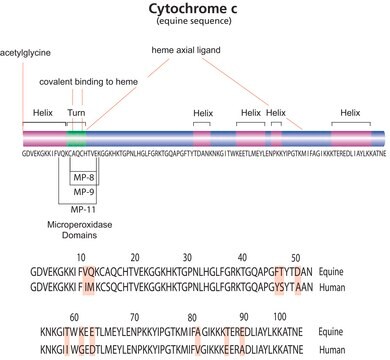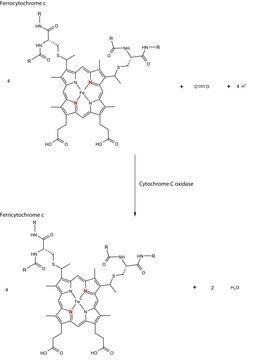C4011
Cytochrome c from pigeon breast muscle
≥95% based on Mol. Wt. 12,173 basis
Sign Into View Organizational & Contract Pricing
All Photos(3)
About This Item
Recommended Products
biological source
pigeon muscle (breast)
Quality Level
Assay
≥95% based on Mol. Wt. 12,173 basis
form
powder
technique(s)
cell culture | mammalian: suitable
storage temp.
−20°C
Looking for similar products? Visit Product Comparison Guide
Application
Cytochrome c has been identified as an important mediator in apoptotic pathways. The release of mitochondrial cytochrome c into the cytoplasm stimulates apoptosis and is commonly used as an indicator of the apoptotic process in the cell. Investigation on the effect of Paris Saponin I (PS I) on human gastric carcinoma cell growth (SGC7901 cells) have shown an elevated level cytoplasmic cytochrome c. Results are an inhibition of proliferation in SGC7901 cells by inducing mitochondria-dependent apoptosis through cytochrome c.
Biochem/physiol Actions
The ready fluctuation of cytochrome c within the cell between ferrous and ferric states, makes it an efficient biological electron-transporter. It plays a vital role in cellular oxidations in both plants and animals. Generally regarded as a universal catalyst of respiration, it forms the essential electron-bridge between the respirable substrates and oxygen.
Preparation Note
Prepared with acetic acid without using TCA.
Other Notes
View more information on cytochrome c and electron transport at www.sigma-aldrich.com/enzymeexplorer.
Storage Class Code
11 - Combustible Solids
WGK
WGK 3
Flash Point(F)
Not applicable
Flash Point(C)
Not applicable
Personal Protective Equipment
dust mask type N95 (US), Eyeshields, Gloves
Choose from one of the most recent versions:
Already Own This Product?
Find documentation for the products that you have recently purchased in the Document Library.
Lin-Lin Gao et al.
World journal of gastroenterology, 17(39), 4389-4395 (2011-11-24)
To investigate the anti-tumor effects of Paris chinensis dioscin (PCD) and mechanisms regarding cell cycle regulation and apoptosis in human gastric cancer SGC-7901 cells. Cell viability was analyzed by the 3-(4,5-dimethylthiazol-2-yl)-2,5-diphenyl-tetrazolium bromide assay. Cell apoptosis was evaluated by flow cytometry
Chris L Bergstrom et al.
Proceedings of the National Academy of Sciences of the United States of America, 110(16), 6269-6274 (2013-04-12)
The release of cytochrome c from mitochondria is a key signaling mechanism in apoptosis. Although extramitochondrial proteins are thought to initiate this release, the exact mechanisms remain unclear. Cytochrome c (cyt c) binds to and penetrates lipid structures containing the
Alexander N Volkov et al.
Biochemistry, 52(13), 2165-2175 (2013-03-23)
Here we present the preparation, biophysical characterization, and nuclear magnetic resonance (NMR) spectroscopy study of yeast cytochrome c peroxidase (CcP) constructs with enhanced solubility. Using a high-yield Escherichia coli expression system, we routinely produced uniformly labeled [(2)H,(13)C,(15)N]CcP samples with high
Xinliu Gao et al.
Archives of biochemistry and biophysics, 535(2), 197-204 (2013-04-17)
The filamentous anoxygenic phototrophic bacterium Chloroflexus aurantiacus possesses an unusual electron transfer complex called Alternative Complex III instead of the cytochrome bc or bf type complex found in nearly all other known groups of phototrophs. Earlier work has confirmed that
Eva Di Silvio et al.
Biochimica et biophysica acta, 1834(8), 1554-1561 (2013-05-08)
The biogenesis of c-type cytochromes (Cytc) is a process that in Gram-negative bacteria demands the coordinated action of different periplasmic proteins (CcmA-I), whose specific roles are still being investigated. Activities of Ccm proteins span from the chaperoning of heme b
Articles
Learn about the four membrane-bound protein complexes that make up the electron transport chain metabolic pathway supplying energy as ATP for cellular respiration.
Chromatograms
application for HPLCapplication for HPLCapplication for HPLCOur team of scientists has experience in all areas of research including Life Science, Material Science, Chemical Synthesis, Chromatography, Analytical and many others.
Contact Technical Service

